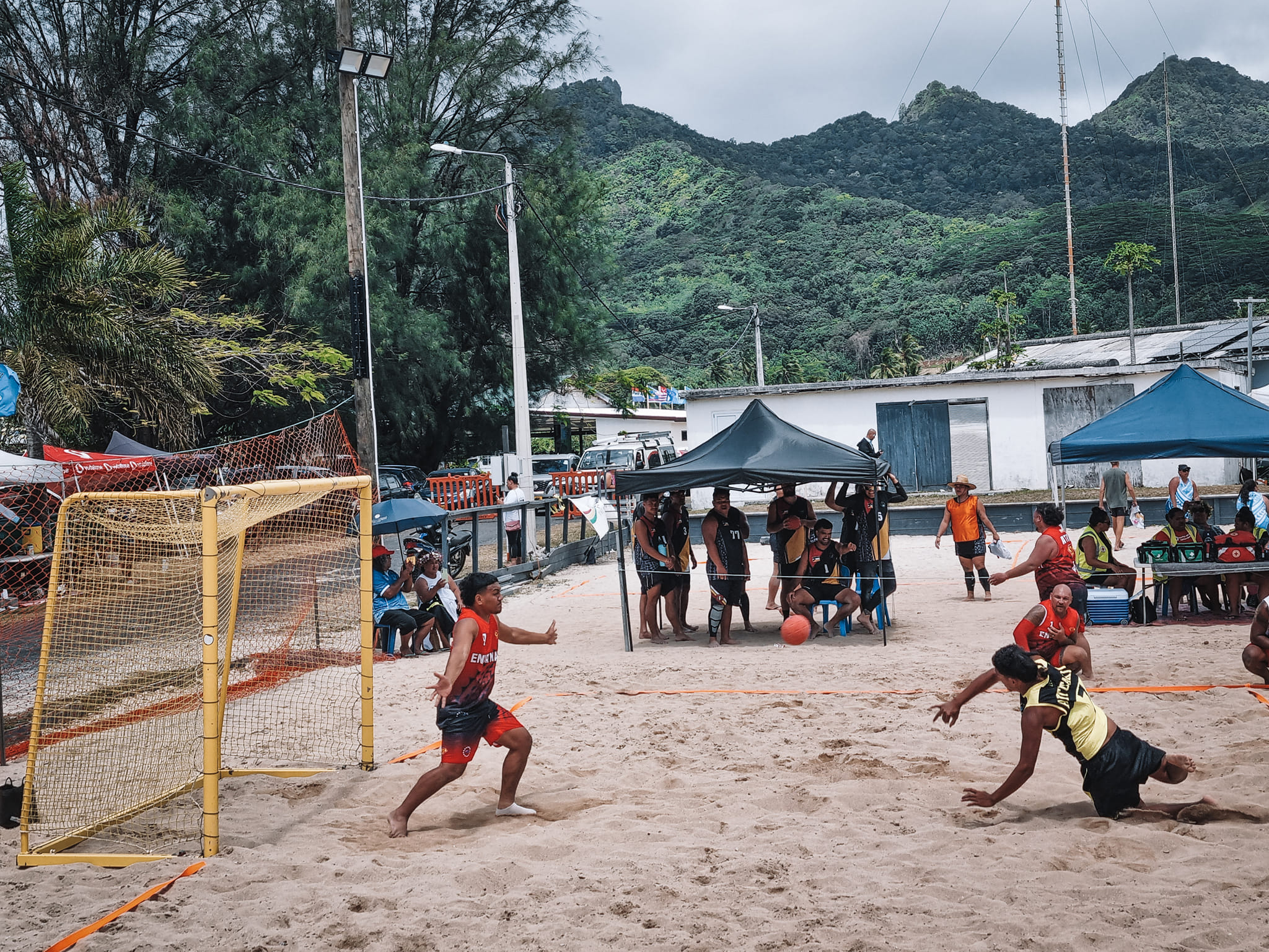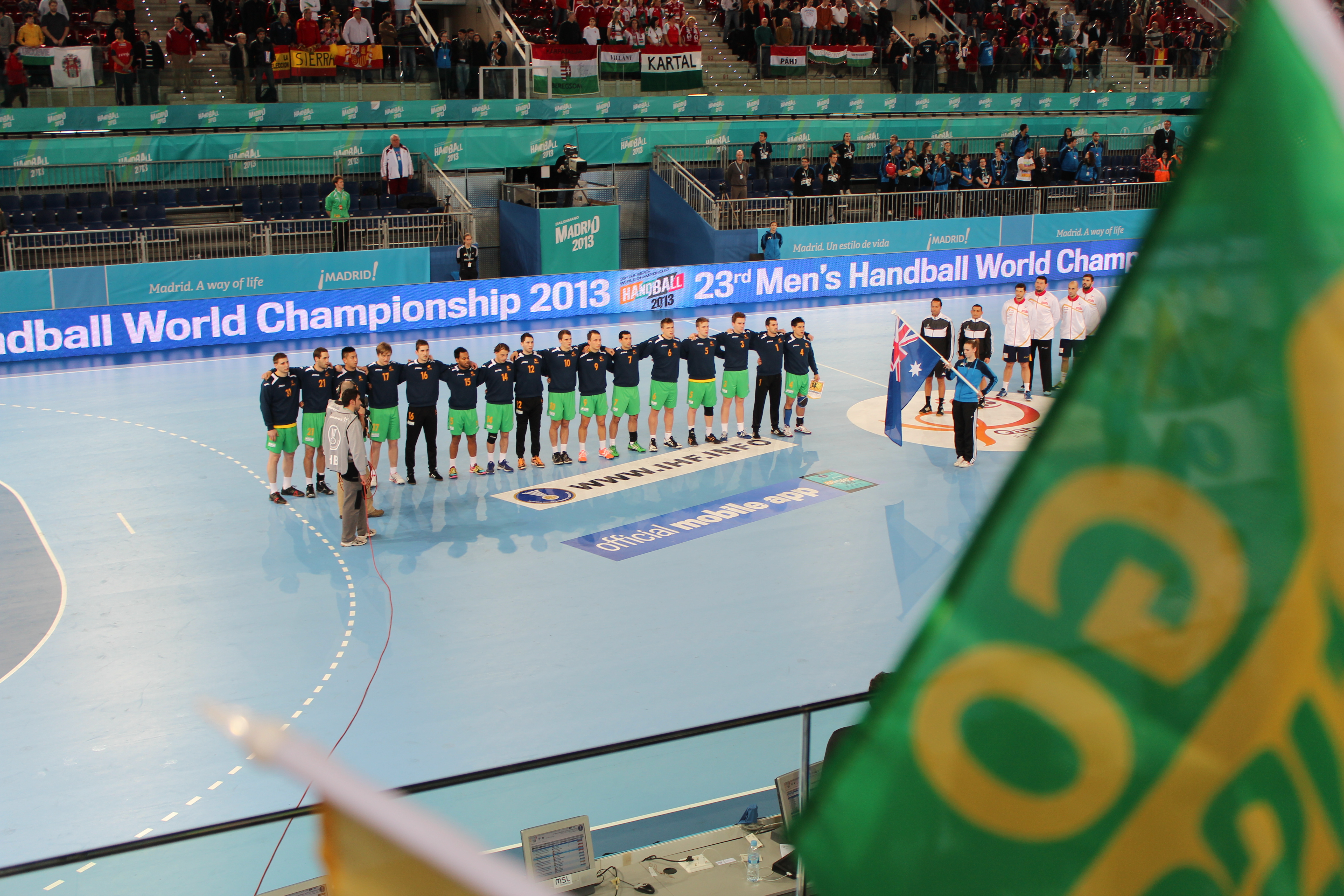
The Australian men’s team sing the national anthem before facing Spain at the 2013 Men’s World Championship in Spain
Former Australian national team player now journalist Courtney Gahan weighs in on the IHF decision to exclude Oceania from the 2015 World Championship and just how important international competitions like the WC are to developing handball nations like Australia.
The initial shock felt by the athletes, officials and the Australian and Oceania handball communities at large following the IHF’s decision to withdraw Australia from the 2015 Men’s World Championship in Qatar may have lessened, but the decision brings with it potentially far greater long-term consequences for the development of handball in a region that has always been working against the odds – and what happens next will determine the fate of not only all the athletes, coaches, officials and countless other volunteers who have dedicated years to seeing their sport grow, but of the sport itself.
Despite the rather late nature of the action by the IHF, the decision to remove Oceania’s compulsory spot could be seen as a blessing rather than a curse – provided alternatives for the teams in the region are put into place. Now is a crucial time for handball in Oceania, and it is important that the countries in this region have the support and assistance of the IHF in finding the path that will not be an easy or short one, but will likely take handball in the area to a much better place.
As someone who has been involved in Australian handball for many years, in almost every capacity there is – from national representative to coach to helping start a new club, not to mention a sibling now part of the men’s national team, I have a great deal of experience and care deeply about handball in this region. I also have experience with handball in Europe, having played in the region myself and now as a contributor to the EHF media. These two regions are almost complete opposites when it comes to handball, a fact that has helped me gain a unique point of view of the current status and future of handball.
The question of development
Handball is not alone when it comes to the difficult question of development in Australia, Oceania or even the world. Countless team sports are ahead of handball in terms of participation, spectators and even any sort of basic knowledge of the game. Then there are a number of sports that have traditionally experienced more of a fight for participation, funding and recognition – sometimes only facing one of these problems but oftentimes a combination. And handball is one that suffers from all three of these issues in the Oceania region.
Sadly, there is little that can be done to increase handball’s funding in Australia. The Australian Sports Commission allocates funding to each sport based on performance history and immediate potential – essentially, a sport has to be able to prove it has a chance of winning a World Championship or equally challenging equivalent. Anyone familiar with Australia’s handball results will be aware this is not an immediate possibility for our teams, so we must move on to other options if we hope to develop – greater levels of participation to increase the pool of players from which to draw and more development opportunities for our current athletes.
The question of increased participation is, in my mind, linked to exposure. I feel certain the level of handball knowledge possessed by most of the Australian public would shock those that grew up with it – I guarantee any Australian involved in handball would be unable to count the number of times they have had to explain the sport to someone.
It is not that handball has no place in Australia; almost any sport can be successful in any country provided it has the opportunity to grow. There is no doubt handball can be loved and participated in enthusiastically by Australians – and it is, by those that have already been lucky enough to stumble across it.
Experience is key
In the end, the question of exposure and funding comes back to the performance of our current national teams. When we begin to record results, handball will gain exposure in Australia and bring with it more participants. There are many factors that contribute to the success of a sporting team, but I would like to isolate one key difference between the Australian and Oceanic teams in comparison with other nations that perhaps can be helped – international experience.
The statistics make it easy to see the crucial gap here – a significant discrepancy exists in number of international matches between players of different countries, especially those between teams from Europe and teams from Oceania. At the end of the 2013 Men’s World Championship, Australia team captain, Bevan Calvert, had recorded 39 matches in the national team – almost ten years after his national team debut in 2004. At just 28 years of age, Calvert is also one of the most experienced and long-serving on the team, a fact which highlights the excessively high turnover in our national squads, due in large part to funding concerns for our athletes.
Comparing Calvert’s number of games, which far outnumber most of the other members of the national squad, to players of the same age from other nations is telling. Take Croatia’s Marko Kopljar and Hungarian Kornel Nagy as examples. Both are Calvert’s age, but each has played upwards of 90 matches for their country. Kopljar debuted on the senior Croatia team at the end of 2008, which puts his average number of international games per year at 15.5, versus Calvert’s 3.9. Obviously there are other factors to consider here, but the fact remains that the only international experience Australia’s players get before they board the plane to the World Championship, where they face a completely different level of play on court, is at the Oceania Handball Nations Championship.
The other relevant question is how long each Australian player can persist in pursuing this difficult endeavour; funding has already been mentioned as a major concern for many Australian handball players, but there is also no denying the challenging experience our athletes undergo through a World Championship tournament is another contributor, as beneficial and extremely meaningful as this experience obviously is. This has meant the core group of athletes continually changes as players decide, for one reason or another, to leave the team. Such high turnover prevents our teams from travelling through the various stages of development together or gaining a comparable amount of cumulative individual experience.
Minority sports and their development in Australia
It is not only handball in Australia that faces the problem of gaining experience for its athletes. Australia’s geographical situation puts it in a region where its national teams tend to dominate most sports. This has meant that many of our teams have had to either become competitive on the world stage in isolation or find an alternative way to gain the experience their athletes need to develop.
There are a number of team sports where Oceania is granted a direct qualification spot or two for the World Championship or equivalent, including basketball, water polo and field hockey, but these are sports where Australia is already on the world map in terms of rankings and results. It is those that are or once were minority sports, such as baseball, volleyball and football, which had to forge a new path for their athletes to gain experience.
Football was played in Australia for over fifty years before the first successful attempt at qualifying for the World Cup in 1974. Location made continued improvement difficult and following the 1974 World Cup, Australia did not qualify again until Germany hosted in 2006. In the meantime Australia began participating in the FIFA Confederations Cup, a position they achieved as Oceania Champions. This tournament enabled the Australian players to gain significant experience and opportunity for development.
In 2006, Australia left the Oceania Football Confederation to join the Asian Football Federation. Australia has qualified for the two World Cups that have taken place since they joined the AFF, and despite not yet being widely recognised as a footballing nation, have contributed to the impressive fan base for the sport that continues to grow within Australia.
Australian volleyball has travelled a long road to get where they are now also, participating in the Asian Championships since the 1970s and only beginning to qualify for Olympic Games and World Championships around the 2000s. Whilst the Australian volleyball team may not be one of the world’s strongest, they have certainly found the road to development and have recorded some encouraging results along the way – namely when they upset winners of the 2012 World League, Poland, by recording a 3-1 victory at the London Olympics against a nation that is considered one of the strongest in the sport.
Baseball in Australia began to increase in popularity in the late 70s-early 80s thanks to the outside influence of coaches coming from the USA that helped develop the national championship into a highly competitive event. The national team recorded victories here and there, but achieved their first notable success in 1997 with a bronze medal at the Intercontinental Cup followed by the gold medal at the same competition in 1999. Perhaps the national team’s biggest achievement was their silver medal at the 2004 Olympic Games in Athens, but there have also been a number of individual successes that have helped the sport gain interest in Australia and encouraged young players who dreamed of the impossible.
Though each of these stories are different, they draw interesting parallels and their lessons can be extremely beneficial to the potential development of handball in Australia, Oceania and the rest of the world. The most common factor of importance that comes from developing each and every one of these sports is experience – it was only when the national teams and athletes across the country started to gain more experience that Australia began to climb global rankings. No matter which path was taken to gain this experience, another undeniable factor is that the respective organisations received assistance and support from neighbouring federations, international expert coaches or the sport’s global governing body.
It is unfortunate for countries that desire to develop in handball that funding and greater awareness of the sport are of such importance, but surely experience is the one area in which handball federations can work together to give all athletes the opportunity to develop. Playing in more international matches would be invaluable for the Australian players, as it would be for our friends within the region and those countries in other regions that share our hopes and likely are full of the same passionate people we have in Australia.
The most positive outcome of the ‘Qatar incident’ is that it highlights the need for development in minority handball regions. Now is the time to consider how further development in Oceania and across all continents can be achieved. Upon first hearing of the IHF’s decision I admit I was concerned it would prove too discouraging for many within the Australian handball community and the sport might suffer dramatically, but I have been inspired to see each part of the organisation – from the board of the Australian Handball Federation to the athletes, become even more motivated by the possibilities that now lie in front of us. I can only hope our motivation and refusal to be forgotten will lead to opportunity, and that our teams will one day earn their place at the World Championships again.







